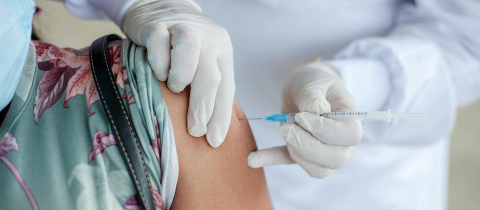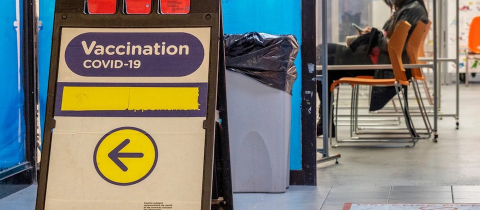Science is hard. This is not meant to dissuade anyone from going into the sciences. It’s just a statement of fact with which all scientists would probably agree, and it’s a sort of mantra we can repeat to ourselves to recalibrate our expectations once in a while. There is a paper that came out in the Proceedings of the National Academy of Sciences (or PNAS) that I fear will be weaponized by anti-vaccine activists. It is not a study that should be casually dismissed, nor can its results be embraced and spun into catastrophic conclusions. Again, science is hard.
It has to do with the claim (and I must repeat, the claim) that the genetic material from the coronavirus could integrate itself inside our own genetic material, that the SARS-CoV-2 RNA could get turned into DNA and mingle with our own. Anti-vaxxers, who downplay the threat of COVID-19, don’t typically see this as a problem with the virus itself; rather, they use this claim (again, claim) to scare the bejesus out of people contemplating one of the COVID-19 vaccines. You see, the COVID-19 vaccines in use right now contain genetic instructions (either RNA or DNA) to tell our body to manufacture the coronavirus’ spike protein. What if, anti-vaccine activists will argue to stir up the flames of anxiety, the genetic material inside these vaccines shoves itself inside your DNA, disrupting the order of things and mutating you in unpredictable ways?
Last December, they found a study they could use to bolster their claim. It had not been officially reviewed by other scientists, and it had not yet been accepted for publication in an academic journal. It was a pre-print. In it, scientists claimed to have discovered bits of the genetic material from the coronavirus fused to human DNA. This pre-print was met with thunderous rebuttals from many in the scientific community, and it was flown as a victory flag by the anti-vaccine movement.
Now, this pre-print has been tweaked, peer-reviewed, and published in the journal PNAS. Its authors claim they “found that DNA copies of SARS-CoV-2 sequences can be integrated into the genome of infected human cells.” It sure sounds scary but, as always, the devil is in the details. And it begins with jumping genes.
Whose LINE is it anyway?
Our organs are made of tissues, and these tissues are made of cells. Inside the cell, there is a glob called the nucleus. It’s the command center of the cell and it contains our DNA. (There are powerhouses outside the nucleus called mitochondria, and they have a tiny ring of DNA, but we will put that aside for today.)
This DNA is a very, very long spaghetti noodle that occasionally bunches up into discrete chromosomes, and that interminable noodle contains stretches that play different roles. There are genes—not as many as we once thought, about 20,000 in humans—and these genes get transcribed into RNA that is itself translated into a specific protein, the effector of the cell.
But protein-coding genes only make up a tiny portion of the entirety of our DNA. If you keep roaming down that long spaghetti noodle, you are bound to see a LINE-1 element. In fact, you will see many. That is because they are estimated to make up about 17% of human DNA or almost one-fifth. They are long stretches of DNA with recognizable sequences and they technically have the ability to pack up their stuff and move elsewhere in the genome. They can jump around.
Most of them, though, are molecular fossils. They used to be able to jump around in our DNA eons ago, but they lost this ability and have been silenced. I reached out to Professor Geoffrey J. Faulkner at the University of Queensland, who studies these jumping bits of DNA like LINE-1 elements. We are known to have about 500,000 of these LINE-1 sequences in our genome. “Of those, in each of us,” he told me, “there are about 100 copies that have the potential to jump. That’s a very small number out of half a million.” And these 100 are not typically seen jumping around in recent times; only about five or six of them do. It’s like our DNA is littered with the tired bodies of long jumpers, with only a handful still able to compete for Olympic gold.
I bring up LINE-1 elements because the authors of that PNAS paper about bits of the coronavirus possibly integrating into our DNA have evidence that puts LINE-1 elements at the scene of the alleged crime. As with most police procedurals, we should not jump to conclusions. What the researchers are alleging based on their laboratory experiments and their scrutiny of the genetic material collected from people with severe COVID-19 is that our own LINE-1 elements—these stretches of DNA that have the machinery necessary to pluck themselves free from the DNA molecule and reintegrate elsewhere—can grab hold of the coronavirus’ RNA that is floating around, transform it back into DNA, and integrate it inside our own DNA as if it were a long jumper competing for the gold.
To be fair, some viruses can do that. Famously, HIV, a retrovirus, comes with the necessary machinery to slide itself into our genome. Some viruses that are not retroviruses can even do that. Our genome and that of other animals bear the marks of many viruses that, over the course of millennia, have been swallowed up by our DNA. But, and this is a telltale “but,” as Professor Aris Katzourakis, who studies the integration of viruses into animal genomes at the University of Oxford and who was critical of this PNAS paper on Twitter, told me, “there are no known integrations of coronaviruses at all in any of the genomes that have been published.”
At the start of the pandemic, he consulted databases out of professional curiosity to see if he could find traces of the genetic material from any of the many coronaviruses in existence integrated in any of the couple of thousands of animal genomes available. He did not find anything even remotely coronavirus-like. After hundreds of millions of years of evolution, despite LINE-1 elements existing and despite coronaviruses infecting animals left and right, there was no trace of coronaviruses having jumped inside animal genomes. What were the odds that this brand-new SARS-CoV-2 coronavirus managed to do just that in a matter of months? “That would be a really big surprise,” he said to me.
When claims meet evidence
The claim that bits of the SARS-CoV-2 virus might be integrated inside our DNA is thus an extraordinary claim given the context. Professor Faulkner reminded me of a famous saying popularized by Carl Sagan—that extraordinary claims require extraordinary evidence—especially when they have public health consequences. “When I think of this [paper], I think of that quote. The claims are extraordinary but the evidence is not.”
One of the reality checks we need to bring up with regards to the paper is that most (but not all) of their data comes from an experimental system that does not reflect reality, but rather acts as a proof of principle. If you eat your first meal with cilantro and you can’t really tell if you like the herb or not, you can buy some cilantro and add a lot of it to your next meal. By increasing the signal (the amount of cilantro), you can detect it better and decide if it pleases you. The researchers here did something similar. They chose a line of human cells they could grow in the laboratory, a line of cells that already expresses a lot of LINE-1, and they gave them a bit of DNA that made even more LINE-1. They wanted to crank up the system—pour a lot of cilantro on top of it—in order to see if anything would happen.
The experts I asked about this agree that doing this is a good first step, but it does not represent what happens when you or I get infected by the coronavirus. You can make something happen artificially that would not happen naturally, including integration. “LCMV, lymphocytic choriomeningitis virus, is a non-integrating virus,” Pr. Katzourakis told me, “but if you stick it in a cell line experiment expressing very, very high levels of LINE-1 and make the cell line permissive, you can make a virus that doesn’t normally integrate into a cell line.”
Moreover, some of the bits of coronavirus genetic material stuck to human DNA that the researchers detected might not be evidence of integration; rather, they may just be artefacts. When copies of genetic material are made, the enzyme that carries the work sometimes behaves like a distracted seamstress, switching off of a piece of fabric and moving on to another, sewing the two together. The coronavirus itself does this, and these artefacts can also be generated by the laboratory technology used by the researchers. This was brought up when the pre-print was published. The researchers tried to take this into account, but it’s still not a slam dunk.
Finally, the sequences they report—those hybrids of coronavirus and human genetic material allegedly created by LINE-1 elements—just don’t look right, according to both the experts I spoke to and the researchers themselves. Indeed, the authors report something strange in their paper. They expected those coronavirus bits would get plopped inside our DNA at random because this is how LINE-1 elements behave. Instead, the bits they saw were 26 times more likely to be found squeezed inside the useful part of our genes. This is very bizarre. Also, certain molecular signatures accompany LINE-1-mediated events, and these signatures are not always there in the sequences reported in this paper, experts tell me. They don’t look right. The authors speculate based on some of these strange results that other mechanisms besides LINE-1 might be involved.
There is a fine LINE between implausible and impossible
I am not worried about the possibility that pieces of the coronavirus might integrate inside my DNA. It has never been seen before with coronaviruses. The evidence presented here is very artificial and unconvincing to me, although I applaud the researchers for not only doing important work but for collaborating with one of their early critics, Stephen H. Hughes, to improve the quality of their paper. I could very charitably say that maybe, maybe there is something there, but better studies are needed.
Even if all this is true (which beggars belief at the moment), it would be a very rare thing indeed, the implications of which are hard to imagine. Two of the authors of the paper were quite clear in a recent interview in the journal Science by stressing that their results “in no way imply that those [COVID-19] vaccines integrate their sequences into our DNA.”
LINE-1 elements, naturally present in our DNA, can jump around on their own, virus or no virus, and so they could, you might think, jump in the middle of an important gene that keeps us from developing cancer and thus help birth a tumour. It has actually happened but there is no reason to panic, as Pr. Faulkner told me. “In the history of cancer genomics, there are a handful of apparently LINE-1-driven cancers. To the extent that they are so rare, I could actually name off the top of my head the papers and the numbers and the work, maybe three or four!”
And speculating even more wildly now, even if the code for the spike protein contained in the vaccine were to integrate into our DNA (which, to be abundantly clear, it does not), it would need to be in the right orientation, it would have to be at just the right place to be expressed and, at worst, that cell would simply produce more spike protein, which would continue to train our immune system to fight the virus, until that cell died. This theoretical, hypothetical integration would not create an infectious virus. No matter how many tires you accumulate, you can’t turn them into a fully functioning car.
That’s why, when the pre-print came out in December, so many science communicators, researchers and doctors were telling people that this idea was highly implausible, bordering on the impossible. Some, however, said “never say never,” a very scientific thing to say, I suppose. After all, what could truly be qualified as impossible in the realm of biology? But as Pr. Katzourakis pointed out to me, “if you say something has a non-zero probability, someone is going to leap on that and totally twist it out of proportion. It’s as close to zero as you could possibly hope for a biological phenomenon to be. It’s that close to zero that it doesn’t worry me.”
Take-home message:
-A peer-reviewed paper was recently published claiming to show evidence supporting the idea that parts of the SARS-CoV-2 coronavirus genetic material could integrate into human DNA
-The evidence mostly comes from a highly artificial laboratory scenario, is at risk of being confused with technological artifacts, and doesn’t look right based on the proposed mechanism of action
-This claim of integration is still highly implausible and the authors of the paper themselves said their study does not imply the COVID-19 vaccines could integrate their DNA or RNA into our genome







